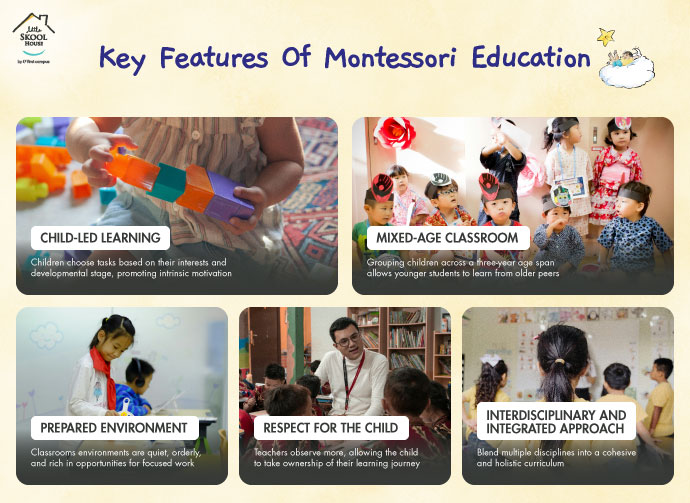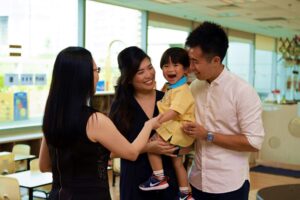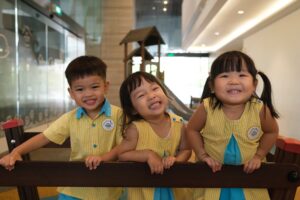BACK
First developed by Dr. Maria Montessori, a medical doctor, in the early 1900s, the Montessori method is an educational philosophy centred around respect for a child’s natural psychological development.
Today, Montessori is known for its child-led approach, mixed-age classrooms, and carefully prepared learning environments that promote independence, self-discipline, and a love of learning.
In an age of fast-paced routines and screen time, Montessori offers a refreshing, mindful alternative focused on the whole child.
For Singaporean parents seeking similar holistic, child-centric approaches, options like The Little Skool House also stand out for their emphasis on bilingual development and inquiry-based learning.
How Was the Montessori Approach Developed?
Dr. Maria Montessori, an Italian physician and educator, observed that children learn best in environments where they can explore and make choices independently.
The Montessori curriculum is individualised, tailored to meet the unique needs, interests, and learning styles of each child. Montessori teachers play an active role in observing and adapting lessons and materials to facilitate each child’s progress within this personalised framework.
Her observations led to the creation of classrooms that were calm, ordered, and filled with tactile learning materials. Montessori designed her first classroom, the “Casa dei Bambini” or “Children’s House,” in Rome for children from low-income families.
The remarkable transformation in these children, from unruly to calm, curious, and motivated learners, cemented her belief in the power of child-centred education.
Over the decades, her philosophy has been adopted and adapted around the world, including by organisations like AMI (Association Montessori Internationale), which works to maintain the authenticity of her methods.
Key Features of Montessori Education

Child-led learning
Children in Montessori classrooms choose tasks based on their interests and developmental stage, promoting intrinsic motivation. The freedom to make choices empowers children to develop responsibility and decision-making skills from an early age.
Montessori teachers play a crucial role in this process by observing and adapting to each child’s development, ensuring that the learning environment supports their individual needs.
Mixed-age classrooms
Grouping children across a three-year age span allows younger students to learn from older peers and fosters a sense of leadership and community. It also helps children progress at their own pace without the pressure of direct competition.
Additionally, older children reinforce their learning by teaching skills they have mastered to younger peers, promoting leadership and collaboration.
Prepared environment
Classrooms are intentionally designed to encourage independence, with child-sized furniture, open shelves, and hands-on materials that support self-correction and exploration. These environments are quiet, orderly, and rich in opportunities for focused work.
Additionally, the use of natural materials in Montessori classrooms contributes to creating a tidy and inviting space that enhances sensory learning and educational accessibility for students.
Respect for the child
Teachers observe more than they instruct, allowing the child to take ownership of their learning journey. This respectful approach recognises the child as competent.
The Montessori philosophy fosters self-directed learning and independence, encouraging students to explore their interests while respecting themselves and their environment.
Interdisciplinary and Integrated Approach
Montessori education is renowned for its interdisciplinary and integrated approach to learning. Unlike traditional schools, where subjects are often taught in isolation, Montessori classrooms blend multiple disciplines into a cohesive and holistic curriculum.
This approach allows Montessori students to see the connections between different areas of knowledge, fostering a deeper understanding of the world around them.
Benefits of Montessori Education
- Independence and self-motivation: Children are given the freedom to choose their activities, which fosters confidence and personal responsibility. As they progress, they learn to manage their time and tasks without the constant intervention of an adult. Montessori materials play a crucial role in promoting active, hands-on learning, allowing children to engage deeply with the content through interactive experiences.
- Emotional and social development: The mixed-age setting and emphasis on grace and courtesy help children learn empathy, patience, and cooperation. The collaborative environment nurtures a sense of belonging and respect for others.
- Academic and real-world readiness: Montessori children often perform well academically, but more importantly, they develop critical thinking, time management, and a genuine love of learning. These skills serve them well beyond the classroom, preparing them for future educational and life challenges.
Montessori Beyond the Classroom
Montessori is not only a great way to ensure children’s growth in class, but also in other day-to-day environments:
Montessori at Home
Many parents incorporate Montessori principles at home through simple practices, like giving children choices, using child-sized tools, and encouraging independence in everyday routines. Setting up accessible spaces, involving children in cooking, or allowing them to dress themselves are just a few ways to promote self-reliance and responsibility.
Parents can also use Montessori language materials to support their child’s learning by providing carefully designed tools that teach distinct skills or concepts, ensuring a logical and developmentally appropriate progression.
Lifelong learning mindset
Montessori education encourages curiosity and adaptability, equipping children to become lifelong learners who approach new challenges with confidence. Because children are guided to follow their interests, they naturally develop a passion for learning that extends into adulthood.
The Montessori method of education fosters a nurturing environment that accommodates diverse learning styles, making it particularly suitable for children with disabilities and neurodivergences.
Considering Other Approaches: The Little Skool House
For parents looking for a strong alternative to the Montessori approach, The Little Skool House provides a holistic, research-backed curriculum rooted in bilingual language development and a strong focus on relationships.
Its inquiry-based approach blends structure with creativity, encouraging children to ask questions, explore ideas, and build confidence in both academic and social settings.
The preschool curriculum at Little Skool House is designed in collaboration with leading early childhood experts and local institutions such as the National Institute of Education (NIE). This ensures that the programme is not only pedagogically sound but also culturally and academically aligned with the Singaporean context.
Children at Little Skool House engage in project work, storytelling, music and movement, and guided discovery—all designed to build strong communication skills in both English and Mandarin.
With a strong emphasis on teacher-child relationships, social-emotional learning, and language acquisition, Little Skool House offers a nurturing environment where children feel safe to take risks and express themselves.
Whether you choose Montessori or a curriculum like that of The Little Skool House, the most important factor is finding a programme that aligns with your child’s needs, interests, and temperament, as well as your family’s values and goals. Early childhood is a foundational stage, and investing in the right environment can shape a child’s love for learning for life.
Choose from 20 Conveniently-Located Centres
Source
- https://www.mariamontessori.org/what-is-montessori/
- https://amshq.org/about-montessori/press-kit/what-is-montessori



